#Stone Construction Acacia Gardens
Explore tagged Tumblr posts
Text
Transforming Homes with Domestic Stone Construction in Acacia Gardens
Acacia Gardens is renowned for its serene surroundings, family-friendly atmosphere, and beautiful homes. An essential element adding charm and durability to these homes is domestic stone construction in Acacia Gardens. Combining aesthetics with functionality, stone construction has become a go-to choice for homeowners looking to elevate their property. In this blog, we’ll explore the growing…
#Commercial Stone Construction Dulwich Hill#Domestic Construction in Acacia Gardens#Domestic Stone Construction in Acacia Gardens#Stone Construction Acacia Gardens#Stonemasons in Dulwich Hill
0 notes
Text
The Bees
Of Honey, Flowers, and Bees

Least Bee
Least Bee that brew – A Honey’s Weight The Summer multiply – Content Her smallest fraction help The Amber Quantity –
—Emily Dickinson

Bee-Master
I have known honey from the Syrian hills Stored in cool jars; the wild acacia there On the rough terrace where the locust shrills Tosses her spindrift on the ringing air. Narcissus bares his nectarous perianth In white and golden tabard to the sun, And while the workers rob the amaranth Or scarlet windflower low among the stone, Intent upon their crops, The Syrian queens mate in the high hot day Rapt visionaries of creative fray; Soaring from fecund ecstasy alone, And, through the blazing ether, drops Like a small thunderbolt the vindicated drone. But this is the bee-master's reckoning In England. Walk among the hives and hear. Forget not bees in winter, though they sleep. For winter's big with summer in her womb, And when you plant your rose-trees, plant them deep, Having regard to bushes all aflame, And see the dusky promise of their bloom In small red shoots, and let each redolent name- Tuscany, Crested Cabbage, Cottage Maid- Load with full June November's dank repose, See the kind cattle drowsing in the shade, And hear the bee about his amorous trade Brown in the gipsy crimson of the rose. In February, if the days be clear, The waking bee, still drowsy on the wing, Will sense the opening of another year And blunder out to seek another spring. Crashing through winter sunlight's pallid gold His clumsiness sets catkins on the willow Ashake like lambs' tails in the early fold, Dusting with pollen all his brown and yellow, But when the rimy afternoon turns cold And undern squalls buffet the chilly fellow, He'll seek the hive's warm waxen welcoming And set about the chambers' classic mould. And then, pell-mell, his harvest follows swift, Blossom and borage, lime and balm and clover, On Downs the thyme, on cliffs the scantling thrift, Everywhere bees go racing with the hours, For every bee becomes a drunken lover, Standing upon his head to sup the flowers, All over England, from Northumbrian coasts, To the wild sea-pink blown on Devon rocks. Over the merry southern gardens, over The grey-green bean-fields, round the Sussex oasts, Through the frilled spires of cottage hollyhocks, Go the big brown fat bees, and blunder in Where dusty spears of sunlight cleave the barn, And seek the sun again, and storm the whin, And in the warm meridian solitude Hum in the heather round the moorland tarn, Look, too, when summer hatches out the brood, In tardy May or early June, And the young queens are strong in the cocoon, Watch, if the days be warm, The flitting of the swarm. Follow, for if beyond your sight they stray Your bees are lost, and you must take your way Homeward disconsolate, but if you be at hand Then you may take your bees on strangers' land. Have your skep ready, drowse them with, your smoke, Whether they cluster on the handy bough Or in the difficult hedge, be nimble now, For bees are captious folk And quick to turn against the lubber's touch, But if you shake them to their wicker hutch Firmly, and turn towards the hive your skep, Into the hive the clustered thousands stream, Mounting the little slatted sloping step, A ready colony, queen, workers, drones, Patient to build again the waxen thrones For younger queens, and all the chambered cells For lesser brood, and all the immemorial scheme. And still they labour, though the hand of man Inscrutable and ravaging descend, Pillaging in their citadels, Defeating wantonly their provident plan, Making a havoc of their patient hoard; Still start afresh, not knowing to what end, Not knowing to what ultimate reward, Or what new ruin of the garnered hive The senseless god in man will send. Still their blind stupid industry will strive, Constructing for destruction pitiably, That still their unintelligible lord May reap his wealth from their calamity.
—Vita Sackville-West

Honey Harvest
Late in March, when the days are growing longer And sight of early green Tells of the coming spring and suns grow stronger, Round the pale willow-catkins there are seen The year's first honey-bees Stealing the nectar: and bee-masters know This for the first sign of the honey-flow.
Then in the dark hillsides the Cherry-trees Gleam white with loads of blossom where the gleams Of piled snow lately hung, and richer streams The honey. Now, if chilly April days Delay the Apple-blossom, and the May's First week come in with sudden summer weather, The Apple and the Hawthorn bloom together, And all day long the plundering hordes go round And every overweighted blossom nods. But from that gathered essence they compound Honey more sweet than nectar of the gods.
Those blossoms fall ere June, warm June that brings The small white Clover. Field by scented field, Round farms like islands in the rolling weald, It spreads thick-flowering or in wildness springs Short-stemmed upon the naked downs, to yield A richer store of honey than the Rose, The Pink, the Honeysuckle. Thence there flows Nectar of clearest amber, redolent Of every flowery scent That the warm wind upgathers as he goes.
In mid-July be ready for the noise Of million bees in old Lime-avenues, As though hot noon had found a droning voice To ease her soul. Here for those busy crews Green leaves and pale-stemmed clusters of green strong flowers Build heavy-perfumed, cool, green-twilight bowers Whence, load by load, through the long summer days They fill their glassy cells With dark green honey, clear as chrysoprase, Which housewives shun; but the bee-master tells This brand is more delicious than all else.
In August-time, if moors are near at hand, Be wise and in the evening-twilight load Your hives upon a cart, and take the road By night: that, ere the early dawn shall spring And all the hills turn rosy with the Ling, Each waking hive may stand Established in its new-appointed land Without harm taken, and the earliest flights Set out at once to loot the heathery heights.
That vintage of the Heather yields so dense And glutinous a syrup that it foils Him who would spare the comb and drain from thence Its dark, full-flavoured spoils: For he must squeeze to wreck the beautiful Frail edifice. Not otherwise he sacks Those many-chambered palaces of wax.
Then let a choice of every kind be made, And, labelled, set upon your storehouse racks — Of Hawthorn-honey that of almond smacks: The luscious Lime-tree-honey, green as jade: Pale Willow-honey, hived by the first rover: That delicate honey culled From Apple-blossom, that of sunlight tastes: And sunlight-coloured honey of the Clover. Then, when the late year wastes, When night falls early and the noon is dulled And the last warm days are over, Unlock the store and to your table bring Essence of every blossom of the spring. And if, when wind has never ceased to blow All night, you wake to roofs and trees becalmed In level wastes of snow, Bring out the Lime-tree-honey, the embalmed Soul of a lost July, or Heather-spiced Brown-gleaming comb wherein sleeps crystallised All the hot perfume of the heathery slope. And, tasting and remembering, live in hope.
—Martin Armstrong

Yellow Roses and Bees, Pink Roses and Wasps, unidentified artist, formerly attributed to Zhao Chang, Qing Dynasty, courtesy The Metropolitan Museum of Art
#literature#poetry#classic#dark academia#classic academia#qing#bees#vita sackville west#emily dickinson
1 note
·
View note
Text
How to Build an Outdoor Fireplace Without Eating Up an Entire Weekend
How to Build an Outdoor Fireplace Without Eating Up an Entire Weekend
Outdoor furnishing is a fantastic way to provide appeal to your patio as well turn it into a more comfortable place to enjoy quiet days. Choosing furniture for the patio takes some careful considerations since it is not something you can buy everyday. Such is quite a great investment, so picking the one which will take probably the most advantage that's definitely worth the money you purchased it for is usually best. Among the many choices for patio furnishing, wood, iron, steel and plastics remain to be one of the most popular through the years. Sure wood, steel and iron makes appealing options. However, they could possess a lots of downsides too. Outdoor furnishing is consistently exposed to a lots of weather change, constant exposure to heat and rain may degrade the standard of wooden chairs. Oftentimes, if not probably the most durable materials are widely-used, the risk for breakage is always there. More so, its being expensive makes this approach quite unattractive. Steel and iron, almost in competing in price with wood, is not a suitable choice when placed outdoors since the rain as well as other climate factors could easily cause rusts in order to create.
Wooden Furniture is the most accepted type of furniture mainly because it blends within the surrounding and imparts it a natural, cozy and synchronized feel. Tables, chairs, swings, lawn bridges, rocking chairs etc all belong to Outdoor Wooden Furniture. They are readily available and can be found almost anywhere, whether it is online retailers or local stores.
If you are having tough time choosing your patio furniture however, here are some ideas. Basically, the toughest moment you will find yourself in when you are furniture shopping is seeking the fitting chair. Why? For there are a lot of chairs as outlined by construction, brand name and material within the furniture shop. There are also seating according to the shape, the paint, the craft etching, and the like that can just make you lightheaded and lost. But the moment you've picked the chair of one's taste, count on me, picking out the rest of one's exterior furniture set would likely be considered a breeze.
Rerate Posts
These are only a few inside benefits we could enjoy if our patio is well-designed. One from your best approaches to put these areas into good use is usually to put a practical and cute garden furniture included. An outdoor dining furniture, a resin wicker outdoor furniture with an outdoor living furniture are great ways for these outdoor areas.These furniture sets can transform these dull and unutilized areas into livelier and functional addition, placing one of the brilliant furniture sets may help in enhancing the appearance from the areas that's well suited for having the admiration individuals guests. Many quality manufacturers provide you having a range of quality teakwood furnishings that could fit your entire outdoor needs. Their extensive various outdoor teak furniture and Teak Outdoor Patio Furniture, including tables, chairs, chaise lounges, sofas, bar tables plus more, will certainly perform best with any outdoor area. Your purchase of quality outdoor furniture is undoubtedly an investment in craftsmanship that will stand test of the time, weather sunlight and rain after which satisfy for years at any given time. Living your health is hard please remember exhausting. With the daily responsibilities outside and within your home, the body must relax and rest following your entire day. And you need not look for another destination to get comfort. All you need is garden furniture as part of your backyard or patio to pamper yourself with comfort whenever you'll need to unwind your whole body and mind.
Rerate Posts
Hummingbird Metal Garden Bench Alvah Slatted Stainless Steel Garden Bench Gabbert Wooden Garden Bench Ismenia Checkered Outdoor Cast Aluminum Patio Garden Bench Elements Storage Bench Ketcha Wood Garden Bench Slate Outdoor Wooden Picnic Bench Sawyerville Poly Lumber Picnic Bench Dragonfly Metal Garden Bench Appleby Aluminum Garden Bench Silvia Outdoor Wooden Storage Bench Montezuma Garden Bench Englewood Wood Garden Bench Cat Metal Garden Bench Arendtsville Picnic Bench Adrianna Vinyl Park Bench Chippendale Bench Tillie Wood Garden Bench Emmalynn Wood Garden Bench Manchester Wood Picnic Bench Wallie Teak Garden Bench Conner Folding Acacia Wood Garden Bench Square Wood Planter Bench Earnest Wooden Picnic Bench Ebron Metal Garden Bench Frank Gehry Entryway Bench Spero Traditional English Plastic Garden Bench Teak Sauna Bench X-Back Hardwood Garden Bench Dock Holiday Bench Swerve Modular Picnic Bench Crockett Picnic Bench 3 Layer Floating Oasis Park Bench Picnic Bench Sickles Outdoor Leopard Shaped Concrete Garden Bench Shullsburg Hourglass Stone Garden Bench Needville Wooden Garden Bench Lisabeth American Pride Flag Metal Garden Bench Snell Sunset High Rise Teak Garden Bench Northgate Metal Park Bench Sakura Teak Garden Bench Fairway Re-Purposed Metal Truck Park Bench Baker Metal Garden Bench Midcourt Park Bench Entryway Iron Garden Bench Laney Garden Bench Milligan Metal Garden Bench Samuel Outdoor Wooden Park Bench Golfer Aluminum Garden Bench Abrego Aluminium Garden Bench Hae Curved Leaf Bench Skyline ArchTec Stainless Steel Garden Bench Margaritaville Southern Most Point Wooden Garden Bench Pitchel Owl Bench Carin Aluminium Garden Bench Uluwatu Picnic Bench Classic Teak Garden Bench Hardwood Doweling Garden Bench Riptide Plastic Bench Linntown Garden Bench Teak Marlboro Lutyens Garden Bench Plastic Garden Bench Jackie Bench Xenia Mesh Glider Bench Wilmoth End Solid Wood Garden Bench Cramden Bench Del-Amo Teak Garden Glider Bench Sparta Wood Picnic Bench Traditional Adirondack Tete-a-Tete Bench Dunloy Wooden Garden Bench Finkel Classic Garden Bench Courtyard Steel Park Bench Classic Westport Plastic Garden Bench Phil Curved Bench Peters Outdoor Rattan Garden Bench Beach Indoor/Outdoor Aluminum Garden Bench Etonbury Solid Wood Garden Bench Adirondack Shell Wood Adirondack Chair Contour Recycled Plastic Park Bench Riptide Wishbone Plastic Bench Cambridge Teak Picnic Bench Butler Park Bench U-Leg Perforated Metal Park Bench Fenham Acrylic Picnic Bench Club Aluminum Picnic Bench Isanti Wooden Garden Bench Sheffield Garden Bench Rod Steel Park Bench Otha Iron Garden Bench Crespin Aluminum Garden Bench UltraSite Recycled Plastic Backless Surface Mount Bench Aire Aluminum Garden Bench Croce Park Bench Picnic Bench Teak Wood Stafford Garden Bench Victory Steel Park Bench Varick Wooden Picnic Bench Victory Perforated Steel Park Bench Standard Expanded Metal Park Bench Courtyard Series Iron Picnic Bench Iron Picnic Bench
1 note
·
View note
Text
How To Pick The Furniture From Twos Company

Your patio or garden has been impeccably prepared, and you now want to unwind. You don't want to carry it out while standing, do you? So you'll probably require a few pieces of contemporary outdoor furniture. Material for twos company furniture comes first on the list of factors. Which is more essential to you: the furniture's appearance or its robustness? Do you have the time and expertise necessary to repair and care for outdoor furniture?
What will suit my lifestyle? And other inquiries should be asked of oneself. You should choose a furniture line from the furniture factory outlet that offers all the furniture you require so you won't need to buy some items at a different store.
There are countless materials available for outdoor furniture, including wicker, resin, aluminum, iron, steel, stone, plastic, and wood. Hard and soft woods can further be used to categorize wooden garden furniture. Among the hardwoods are Teak, mahogany, acacia, or oak. Pine, spruce, larch, and fir are examples of softwoods. Details are listed below.
1. Resin
The main component of resin patio furniture is polymer, a high-density variant of polyethylene plastic. Both UV light and water resistance are present in this substance. This material is strong and designed to endure various severe weather conditions. With the exception of the occasional cleaning with water and soap, furniture constructed of synthetic resin requires no upkeep. But there are certain drawbacks to this substance as well. Resin is significantly heavier than wicker and is not biodegradable. Generally speaking, resin furniture costs increase with weight.
2. Wicker
Compared to resin furniture, wicker patio furniture has a far longer history. Ancient Chinese and Egyptians employed reeds, willow, and rattan to construct furniture thousands of years ago. Willow, rattan, or reed are some of the materials used to make wicker furniture. Additionally, it is highly strong, although it is not weatherproof. It produces a rustic, earthy feeling that is ideal for outdoor use.
Wicker is lighter and biodegradable than resin since it is natural. It is susceptible to mildew and decay in humid environments. Because of this, it typically needs to be pre-treated with lacquer or varnish before being used outside. Furthermore, prolonged UV exposure will cause wicker to split and shatter.
3. Metal
Metals have a lot of sway over the aesthetic of your outdoor furniture. With options ranging from contemporary lightweight aluminum to more classic iron, finding the ideal piece of metal garden furniture for your yard should be feasible. Many experts advise using aluminum since it is more rust-resistant while being more expensive.
4. Teak - an old favorite
The majority of consumers select teak garden furniture because it is the most durable of all hardwoods. With teak garden furniture, you can never go wrong because it is timeless, elegant, natural, and, most importantly, it will last for decades. An excellent location to start any outdoor renovation project is Indonesian teak garden furniture.
In addition to the wood's quality, other factors like the furniture's construction are taken into account while purchasing teak garden furniture.
Make it a routine to inspect the fractures or splintered wood. It's a good idea to wash with warm, soapy water to get rid of dirt and dust, especially before using teak oil (do not forget to let the wood dry beforehand).
Be aware that materials send a style message. In general, resin furniture speaks of practicality, wood furniture conveys a warm, rustic feeling, and wicker patio furniture is viewed as romantic. Aluminum gives your landscape a more modern appearance than iron does.
0 notes
Text
THE CLASSICAL ELEMENTS IN WICCA

Elements—they are the building blocks of the entire universe. No, I’m not talking about the scientific elements, such as is found on the periodic chart. Sure, they are the building blocks for the physical universe. But I’m referring to the spiritual or classical Elements—they are the metaphysical building blocks.
Mention of Air, Earth, Fire, Water, and Aether (Spirit) are something Wiccans will come across time and again. Regardless of how big or small a role the Elements play in your personal spiritual path, they’re something you should learn to understand.
BIG “E”AND LITTLE “e”
Sometimes I write ‘Element’, and sometimes ‘elements’. Sometimes I capitalize Air (Earth, Fire, etc.), and sometimes I don’t. There’s actually a reason for it.
Remember the Periodic Table of the Elements from chemistry class? There are 118 known elements and all matter breaks down to these most basic components. When speaking of scientific elements, I use the little “e”.
In ancient Greece, the concept of the Elements (the classical/spiritual ones) was born. They did not have the technology to see atoms and molecules, so they thought everything was made up of some combination of Air, Earth, Fire, Water and Aether.
Fast forward a couple dozen centuries-- now we know that air, earth, fire, water and aether are compounds-- a mixture of smaller elements on the periodic table. For example, water is a compound of hydrogen and oxygen.
This is the reason for the distinction. The Elements (capital E) refer to the spiritual/classical Elements of our religion—those forces that we honor. The elements (lowercase e) refers to the actual scientific elements on the periodic table.
THERE’S MORE TO ELEMENTS THAN COMPOUNDS
We all know the Elements are Air, Earth, Fire, Water, and Aether. Sometimes people confuse this with earth, air, fire, water and ether. Note my use of capitalization here, because it's very significant.
The Elements—Air, Earth, Fire, and Water—are not the same thing as wind, dirt, flames, and H20. These compounds are meaningful representations of the Elements of course, but the compounds themselves are not Elements. The Elements (capital 'E') are so much more than the compounds for which they are named.

THE ELEMENTAL CONNECTION
The Elements represent all things, and connect all things. Look at the diagram above; you can see the vertical axis contains the masculine Elements (Air and Fire). The horizontal Axis contains the feminine Elements (Water and Earth). The circle is where the Elements meet, as if at a crossroads. The circle surrounds and connects the four Elements, just as Aether (Spirit) is the unifying and balancing factor that runs through everything in the universe—the soul, the divine, it’s what gives life and meaning to all things.Notice how they are equivalent in length and well balanced. When you go around the circle, you get the polarity alternating the masculine and feminine Elements, the projective and receptive, the positive and negative: Kind of like an electric charge (energy!).You might even envision it as a compass, with each Element at one of the cardinal directions. You can even set up the primary altar tools as in some traditions in that same format: the athame is a symbol of Air, the pentacle a symbol of Earth, the wand a symbol of Fire, and the cup a symbol of Water.

CORRESPONDENCES—JUST THE START
Notice in the diagram above in the innermost circle we have our compass and our male/female axis. Beyond that we have correspondences to the directions, time of day, time of the year/season, the sabbats—even the life cycle itself. You get a taste right there at how the Elements correspond to everything; and everything corresponds to one or more of the Elements.
This is just the tip of the iceberg, really, as Elements also correspond to zodiac signs, tarot cards, runes, herbs, gemstones, deities, personality traits, occupations, body functions, activities, etc....the cycles and connections are endless.

IN RELATION TO THE PENTAGRAM
Each pentagram point represents an element. This is why the pentacle is the ultimate symbol of balance—each equal point, all intertwined with each other—balance is a key tenet in Wicca. Wiccans usually wear a pentacle point-up. We move from the point at top (Aether) the intangible, to the semi-intangible realm (Fire and Air) to the tangible realm (Water and Earth). I say usually because some Wiccan trads also occasionally use the pentagram point down. When the pentagram is point up, it stands for Spirit (Aether) ascending over matter. When it’s point down, it represents Spirit descending into matter. As you can see, the Elements are a rich, diverse, and complex system of symbols and energies that effect our world, our minds, and our spiritual practices. Take advantage of their potential by learning to work in harmony with them.
THE ELEMENTS IN DEPTH
Please keep in mind that correspondences can vary from tradition to tradition, from person to person. Though there are more similarities than differences, never take any list of Elemental correspondences as written law.
THE ELEMENT OF AIR:

(Figure above shows alchemical symbol for Air)
Gender: Masculine
Charge: Positive
Energy: Active
Qualities: abstract; ethereal
Aspects: analytical thought; rational mind; travel; communication
AIR ATTRIBUTES:
Positive: witty, intelligent, communicative, inquisitive, inventive, literary, social, idealist, clarity of thought, rational, technical, scientific, logical
Negative: aloof, cold, dispassionate, eccentric, scattered, unfocused, ambivalent, indecisive, deceptive, untrustworthy.
AIR ALIGNED WITH:
Day of the Week: Wednesday
Direction: North
Locations: Mountain tops, sky, clouds
Sabbats: Samhain, Yule
Time of day: Night
Time of Life: Death through Rebirth
Time of the year: Winter
Wind: Boreas
Witch’s Pyramid: To Know
AIR RULING OVER:
Body parts: brains, nervous system, lungs
Bodily functions: breathing, thinking, speaking, singing, coughing, whistling, belching, flatulating
Colors: yellow, white, sky blue, midnight blue, shades of gray
Incense: sandalwood, storax, mastic
Instruments: woodwinds, bagpipes
Careers: accounting, acting, advertising, executive, astronaut, computer programmer or technician, con artist, gambling, judge, lawyer, mathematician, public speaker, sales, most kinds of sciences, singing, teaching, writing.
Sense: Smell
AIR CORRESPONDING TO:
Herbs: Acacia, almond, anise, benzoin, bergamot, bistort, bittersweet, borage, bromeliad, broom, caraway, chicory, citron, clover, dandelion, elecampane, endive, eyebright, fenugreek, goat’s rue, hazel, hops, houseleek, lavender, lily, linden, mace, male fern, maple, marjoram, mastic, meadowsweet, mint, mistletoe, palm, papyrus, parsley, pine, pistachio, rice, sage, saffron, slippery elm, wormwood
Metals: mercury, aluminum
Minerals & Gems: agates, aventurine, amethyst, jasper, mica, pumice
Runes: ANSUZ, RAIDO, EIWAZ, ALGIZ, TIR, MANNAZ
Tarot: Suit of swords, knights, The Fool, The Magician, The Lovers, The Hermit, Hanged Man, Justice, The Star
Wiccan tools: knives (athame, bolline)/swords, censer, incense
Zodiac: Gemini: (mutable); Libra (cardinal); Aquarius (fixed)
AIR ASSOCIATED WITH:
Animals: birds, flying insects, spiders, bats, foxes, primates
Elemental Beings: Sylphs, fairies, djinn
Gods: Allah, Amergin, Anu, Apollo, Ascepius, Baal, Buddha, Ganesha, Hermes, Jupiter, Mercury, Odin, Thoth, Tyr, Uranus, YHWH, Zeus
Goddesses: Arachne, Arianrhod, Athena, Ishtar, Juno, Ma’at, Minerva, Mnemosyne, Morrigan, Muses, Mt, Neith, Nike, Nuit, Sarasvati
Mythical Creatures: Gryphons, Harpies, Hippogrifs, Pegasus, Sphinx
INVOKING AND BANISHING AIR
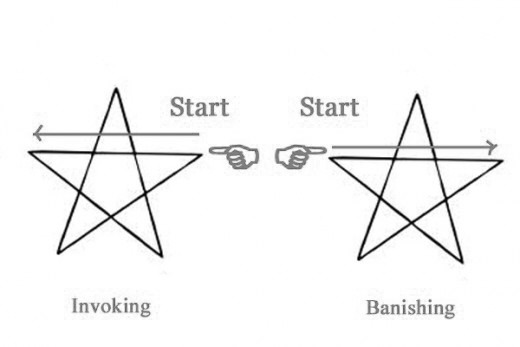
THE ELEMENT OF EARTH

(Figure above shows alchemical symbol for Earth)
Gender: female
Charge: negative (-)
Energy: passive
Qualities: physical matter; solid; heavy; cold
Aspects: tangible world; fertility; growth; productivity
EARTH ATTRIBUTES:
Positive: ambitious, dependable, diligent, earthy, industrious, practical, pragmatic, reliable, responsible, stable, steady, thorough
Negative: critical, dull, inhibited, materialistic, obstinate, possessive, slow, stubborn, unforgiving
EARTH ALIGNED WITH:
Day of the Week: Thursday, Saturday
Direction: East
Locations: caverns, plains, canyons, the underworld
Sabbats: Imbolc, Ostara
Time of day: Morning
Time of Life: Youth
Time of the year: Spring
Wind: Euros
Witch’s Pyramid: To Will
EARTH RULING OVER:
Body parts: physical self, bones
Bodily functions: eating, defecation
Colors: green, brown, black, earth tones
Incense: patchouli, musk
Instruments: drums, percussion
Occupations: armed forces, banking and finances, carpentry, construction, child care, cooking and food service, clerical and administrative work, dancing, gardening, house keeping/home making, hunting, janitors, jewelers, mechanics, stone masons, wood workers.
Sense: touch
EARTH CORRESPONDING TO:
Herbs: alfalfa, barley, corn, cotton, cypress, fern, fumitory, honeysuckle, magnolia, mugwort, oats, peas, oleander, patchouli, potato primrose, quince, rhubarb, rye, sagebrush, sorrel, tulip, vervain, vetivert, wheat
Metals: lead
Minerals & gems: green agates, moss agates, alum, green calcite, coal, emerald, jasper, jet, salt, malachite, olivine, peridot, black tourmaline, green tourmaline, turquoise
Runes: URUZ, GIFU, BEORK, ING, OTHAL, JERA
Tarot: Suit of Pentacles (coins), Paiges, Empress, Heirophant, Wheel of Fortune, The Devil, The World
Wiccan tools: Pentacle, consecrated salt
Zodiac: Taurus (fixed); Virgo (mutable); Capricorn (cardinal)
EARTH ASSOCIATED WITH:
Animals: most mammals (few exceptions: big cats and horses/Fire; primates and foxes/Air; aquatic mammals/Water); most insects without wings (exception: fire ants/fire); earthworms.
Elemental Beings: Gnomes, elves, leprechauns
Gods: Adonis, Anubis, Cernunnos, Dagda, Dionysus, Green Man, Hades, Herne, Janus, Osiris, Pan, Pluto
Goddesses: Anu, Cerridewen, Ceres, Demeter, Gaia, Fauna, Frigga,Hecate, Nepthys, Ostara, Persephone, Prithivi, Rhea
Mythical Creatures: big foot, chupacabra, giants, jackalope, unicorn, werewolves, wraiths
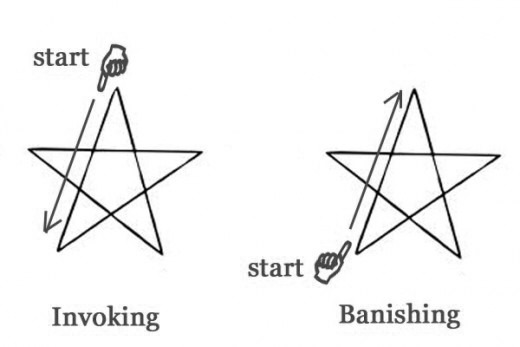
THE ELEMENT OF FIRE

(Figure above shows alchemical symbol for Fire)
Gender: Masculine
Charge: Positive
Energy: Active
Qualities: energetic; transformative; purifying
Aspects: passion; will; courage
FIRE ATTRIBUTES:
Positive: action-oriented, courageous, eager, enthusiastic, exciting, impulsive, independent, optimistic, quick, spontaneous, tenacious, vivacious
Negative: angry, abrupt, consuming, domineering, egocentric, excessive, hot-tempered, impatient, overbearing, overwhelming
FIRE ALIGNED WITH:
Day of the Week: Sunday, Tuesday
Direction: South
Locations: deserts, volcanoes
Sabbats: Beltane, Litha
Time of day: Midday (true noon)
Time of Life: young adulthood
Time of the year: Summer
Wind: Notus
Witch’s Pyramid: To Dare
FIRE RULING OVER:
Body parts: genitals, heart, intestines, liver, stomach
Bodily functions: digestion, sex, metabolism, regurgitation, smoking
Colors: red, orange, gold
Incense: cinnamon, dragon’s blood
Instruments: brass instruments
Occupations: alchemists, assassins, athletes, electricians, firefighters, fire dancers, lion tamers, martial artists, nuclear physicists, pyro technicians, smiths, warriors, welders
FIRE CORRESPONDING TO:
Herbs: allspice, basil, bloodroot, cactus, carnation, bay, capsicum, cinnamon, clove, cinquefoil, copal, coriander, cumin, curry, dill, dragon’s blood, fennel, flax, frankincense, galangal, ginger, ginseng, High John the Conqueror, holly, hyssop, juniper, lime, marigold, nutmeg, orange, pennyroyal, pomegranate, rosemary, saffron, sunflower, St. John’s wort, tobacco, Venus flytrap
Metals: gold, brass, steel, iron
Minerals: red agates, amber, apache tear, asbestos, bloodstone, carnelian, citrine, quartz, obsidian, onyx, sand, rhodochrosite, tiger‘s eye, tourmaline, zircon
Runes: Fehu, Thurisaz, Kenaz, Nied, Sigel, Dagaz
Tarot: Suit of Wands; all kings; the Emperor; Strength; Temperance; the Tower; the Sun; Judgement
Wiccan tools: wand; staff; candles; any fires
Zodiac: Aries(cardinal); Leo (fixed); Sagittarius (mutable)
FIRE ASSOCIATED WITH:
Animals: lions, felines, fireflies, glow worms, horses, rams, lizards, fire ants
Elemental Beings: salamanders
Gods: Annu, Ares, Balor, Baldor, Belanos, Frey, Hephaestus, Horus, Loki, Lucifer, Lugh, Marduk, Mars, Ra, Set, Shiva, Sol, Thor, Vulcan
Goddesses: Amerterasu, Amat, Atlanta, Bast, Brigit, Eris, Freya, Hestia, Kali, Lilith, Nemisis, Pele, Selket, Shatki, Sunna, Vesta
Mythical Creatures: chimeras, dragons, phoenix
INVOKING AND BANISHING FIRE

THE ELEMENT OF WATER

(Figure above shows alchemical symbol for Water)
Gender: Feminine
Charge: Negative (-)
Energy: Passive
Qualities: receptive, fluid, creative
Aspects: formless, deep, cleansing
WATER ATTRIBUTES:
Positive: beautiful, compassionate, creative, deep, flexible, intuitive, mysterious, resourceful, receptive, sensitive, sensual, understanding
Negative: ambivalent, complex, deceptive, emotional, moody, over-sensitive, passive-aggressive, selfish, vain, wishy-washy
WATER ALIGNED WITH:
Day of the Week: Monday, Friday
Direction: West
Locations: any body of water, seashore/beaches
Sabbats: Lughnasadh, Mabon
Time of day: Twilight/Sunset
Time of Life: maturity
Time of the year: Autumn
Wind: Zepher
Witch’s Pyramid: To be silent
WATER RULING OVER:
Body parts: bodily fluids—blood, saliva, semen, urine, etc.; the womb
Bodily functions: drinking, lactating, menstruating, perspiring, secretion, urination
Colors: blue, silver, aquamarine
Incense: cypress, lotus, myrrh
Instruments: string instruments
Occupations: bartender, brewer, cosmetologist, pet, dishwasher, diver, dowser, fishing, hematologists, ice skaters, laundry workers, life guards, marine biologists, naval careers, oceanographers, painters, psychics, sailors, swimmers, surfers
Sense: Taste
WATER CORRESPONDING TO:
Herbs: African violet, apple, avocado, belladonna, blackberry, boneset, cabbage, cardamom, catnip, chamomile, chickweed, dittany of Crete, daisy, cucumber, daffodil, gardina, heather, hibiscus, jasmine, myrrh, poppy, rose, sandalwood, thyme, valerian, vanilla, willow, yarrow
Metals: silver
Minerals: blue lace agate, aquamarine, azurite, beryl, coral, geodes, jade, lapis lazuli, moonstone, pearl, sapphire, sodolite, tourmaline
Runes: Wunjo, Ehwaz, Hagall, Isa, Phedro, Lagaz
Tarot: Suit of Cups; all Queens; High Priestess; Death; The Moon; The Chariot
Wiccan tools: cup; cauldron; bowls
Zodiac: Cancer (cardinal); Scorpio (fixed); Picses (mutable)
WATER ASSOCIATED WITH:
Animals: fish, scorpions, serpents, waterfowl, water mammals, creatures who dwell/live in water
Elemental Beings: Undines
Gods: Aegir, Charon, Cthulhu, Nun, Dagon, Eros, Hurican, Lyr, Neptune, Nereus, Oceanus, Poseidon, Triton
Goddesses: Amphitrite, Aphrodite, Astarte, Heket, Isis, Kwan Yin, Lady of the Lake, Mary, Melusine, Psyche, Styx, Tefnut, Thetis, Venus
Mythical Creatures: hippocampus, kraken, leviathan, merfolk, nerids, selkies, sirens, waterhorse, any sea monsters
INVOKING AND BANISHING WATER
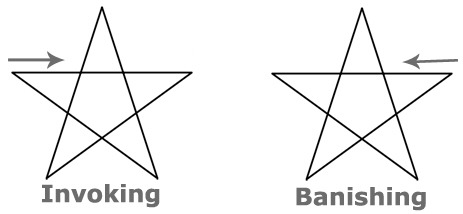
FINDING YOUR ELEMENT IN WICCA
A lot of young Wiccans are eager to find their elements. I don’t mean to burst any bubbles, but traditionally in Wicca there is no such thing. Yes, you read that right. I know that’s not a popular opinion these days because the idea has gained recent popularity, but please follow my reasoning before you dismiss it.
It should be understood, as explained earlier, Elements Earth, Air, Fire, Water are not the same thing as dirt, oxygen, flames and H20. The Spiritual Elements – capital “E” – together make up everything in life. For Example, the Element of Water (capitalized) is not just the stuff that pours out of your faucets or fills your pool. Water is H20, and H20 is the most pure symbol of the Element, but the Element of Water is so much more than that. It’s also intuition, it’s string instruments, it’s silver jewelry, it’s fish, it’s the moon, it’s being wishy-washy, it’s being nurturing, it’s both compassion and depression, it’s drowning, it’s the sunset hour, it’s peeing and drooling. The Element of Water is infused in every aspect of life, and this is so with the other three as well.
Second, the very notion that someone is “an Element” would contradict a key tenet of Wicca—which is to find balance in all things. If you were one Element, you would be an incredibly imbalanced person. If you lean that heavily toward one Element, it would mean you need less of it, and you need more of the other three.
Some would argue, saying something like: But my astrological sign is (fill in the blank), making my Element (fill in the blank)! Yes, I know—astrological signs fall under the Elements as well. Just because your astrological element’s influence is Water doesn’t mean Water is your only Element. For one thing, your Sun sign is not your only astrological sign (you also have a Moon sign, an Ascending sign, and all those houses in your chart with different planets).
Water touches everyone’s life in many ways, as do all the Elements. One of the ways it influences you is through your Sun sign; that doesn't make it your one and only Element.
But I have an affinity for (fill in the blank) because (fill in the blank)! The word “affinity” simply means you like something. I have an affinity for chocolate, that doesn’t make me the element of chocolate (though—it might be fun).
Once you’ve gotten the idea in your head that you have a special element, it’s a little hard to shake. I know that I have a special connection with each of the elements and balance is key, but I can’t help but feel drawn to Air. Why is this? Air correlates with my Zodiac sign, Libra, as well as the signs Aquarius and Gemini. The Law of Correspondence would suggest that Air is associated with the personality types of these signs. Yes, Air broadly represents my personality type but it does not make it my only element (or predominant element) and it does not make myself Air. Air is my challenger, the element that constantly influences me to reach out to the other elements to find balance. Always remember, balance is key.
CONTROLLING ELEMENTS
The idea of controlling Elements in Wicca is another misconception. I’m not going to argue here whether it’s even possible to control fire or water or air with your mind—and I don’t even know how someone would go about controlling earth (other than gardening or making mud pies). Even if this was possible, this would fall under the category of psychic abilities. While a Wiccan might believe in this stuff, or attempt to perform these tasks, it does not make doing these things part of our religion.
I do have to note here, the idea of "controlling elements" seems to me an incredible waste of time and energy. Let’s assume here for a second people who claim they have these powers can actually do what they say they do. They cause a flame to flicker or a little feather to bounce around or water to ripple at will. That’s all fine and good, but I ask… what is the spiritual lesson and benefit in this?
The amount of practice and effort that goes into what amounts to little more than a neat trick to show off with at parties is ridiculous. How does it actually help someone’s spiritual journey to waste an hour or two a day for months to learn how to make the candle flame bob up and down? It seems to me there is no actual spiritual benefit from being able to do these things—it’s just something you can use to impress yourself and your friends, like juggling 3 oranges or finding someone’s card in a deck.
Allow me to repeat myself, because I feel it’s a very important point that many Wiccans miss: the Element of Fire is not just flames, the Element of Water is not H20, and so on. Controlling a flame with your mind (even if you could) is not the same thing controlling the Element of Fire. You’re just controlling a bit of fire (small “f”). Controlling H20 is not controlling the Element of Water; it’s controlling water (small “w”). And so on.
REALLY CONTROLLING THE ELEMENTS IN WICCA
In Wicca, controlling the Elements isn’t about making candle flames dance or creating gusts of wind with your mind. Controlling the Elements is about finding self-control and balance within yourself and your life.
You want to control the Element of Fire? Don’t play with candle flames—learn how to control your temper. Learn how to nurture your passions and channel them productively. Work on expressing yourself artistically.
You want to Control the Element of Water? Don’t play with running faucets to see if you can make the flow shift an inch over—learn how to master your emotions. Learn how to be more compassionate and understanding. Learn how to listen to and interpret your intuition. Learn how control your mood swings.
You want to Control the Element of Air? Study, learn, and apply your knowledge to life. Practice speaking, help yourself learn to think more carefully about what comes out of your mouth and express yourself more effectively. Don’t allow yourself to give into cynical attitudes. Cultivate wisdom.
You want to Control the Element of Earth? Have courage, and do the things that need to be done in your life-- even the hard stuff. Be strong and steadfast—but try to work on not being so stubborn and closed off to anything new. Be practical and pragmatic, put the work and time into developing useful skills.
Learn to work with Elemental Energies—not by playing with one, single physical manifestations of each Element, but by learning to open yourself to them and all they mean. Think about what they symbolize in ritual, what aspects of life they correspond to, and how you can better utilize that understanding to improve yourself internally. Find Elemental balance.
FINDING TRUE BALANCE
While it's true that a certain Element can be dominant in your life (either for your whole life, or for certain periods of it), that doesn't make you "an Element," and it doesn't mean you are intrinsically tied to it, like it or not. It doesn't mean it should be your focus, either in your life or in your spiritual practices (again, it could indicate your need to bring better Elemental balance). Further, it doesn't imply supernatural connection to or power over the Element.
I know a lot of people who came to Wicca more recently and started with books and websites that tout the “find your element” concept, and it’s very hard to think of things differently when you get used to them. Some will even get defensive when such ideas are challenged. I also know some people like the idea of having supernatural mastery over nature, and this very idea is what drew them to alternative religions in the first place. I understand that learning to control your temper is not as exciting and flashy a representation of Fire to some people as making a candle flame do flickering tricks. “You can’t tell me what to believe!” some might cry. And I’m not telling you what to believe. You can believe what you want.
I’m presenting a perspective that I feel needs to be heard, and that some may find more useful. I believe the ideas about the Elements presented here makes real sense within the context of the Wiccan religion, as well as in life. It may contradict a lot of the more feel-good, fanciful ideas you come across, and if that makes you angry, feel free to ignore anything I have to say on the topic.
However, if you were looking for something a little deeper than parlor tricks and games, if you were looking for a spiritual path to actually impact your life, your personal growth and your spiritual development, I hope this lesser known perspective on the topic will help you along.
TRADITIONAL WICCAN ELEMENT CHANT:
“Earth my body, Water my blood, Air my breath and Fire my Spirit”
Sources: WiccanSage and Golden Dawn by Israel Regardy
#pagan#wicca#wiccan#witchcraft#witches of Tumblr#witch#magick#spell#pentacle#pentagram#easy spell#the craft#paganism#amethyst#moon#full moon#eclipse#nature#neo wiccan#neo pagan#gif#fashion#art#landscape#design#quote#elements#fire#earth#air
3K notes
·
View notes
Text
Caligula’s Garden of Delights, Unearthed and Restored

The fourth of the 12 Caesars, Caligula — officially, Gaius Julius Caesar Germanicus — was a capricious, combustible first-century populist remembered, perhaps unfairly, as the empire’s most tyrannical ruler. As reported by Suetonius, the Michael Wolff of ancient Rome, he never forgot a slight, slept only a few hours a night and married several times, lastly to a woman named Milonia.
During the four years that Caligula occupied the Roman throne, his favorite hideaway was an imperial pleasure garden called Horti Lamiani, the Mar-a-Lago of its day. The vast residential compound spread out on the Esquiline Hill, one of the seven hills on which the city was originally built, in the area around the current Piazza Vittorio Emanuele II.
There, just on the edge of the city, villas, shrines and banquet halls were set in carefully constructed “natural” landscapes. An early version of a wildlife park, the Horti Lamiani featured orchards, fountains, terraces, a bath house adorned with precious colored marble from all over the Mediterranean, and exotic animals, some of which were used, as in the Colosseum, for private circus games.
When Caligula was assassinated in his palace on the Palatine Hill in 41 A.D., his body was carried to the Horti Lamiani, where he was cremated and hastily buried before being moved to the Mausoleum of Augustus on the Campus Martius, north of the Capitoline Hill. According to Suetonius, the elite garden was haunted by Caligula’s ghost.
Historians have long believed that the remains of the lavish houses and parkland would never be recovered. But this spring, Italy’s Ministry of Cultural Heritage, Cultural Activities and Tourism will open the Nymphaeum Museum of Piazza Vittorio, a subterranean gallery that will showcase a section of the imperial garden that was unearthed during an excavation from 2006 to 2015. The dig, carried out beneath the rubble of a condemned 19th-century apartment complex, yielded gems, coins, ceramics, jewelry, pottery, cameo glass, a theater mask, seeds of plants such as citron, apricot and acacia that had been imported from Asia, and bones of peacocks, deer, lions, bears and ostriches.
“The ruins tell extraordinary stories, starting with the animals,” said Mirella Serlorenzi, the culture ministry’s director of excavations. “It is not hard to imagine animals, some caged and some running wild, in this enchanted setting.” The science of antiquities department of the Sapienza University of Rome collaborated on the project.
The objects and structural remnants on display in the museum paint a vivid picture of wealth, power and opulence. Among the stunning examples of ancient Roman artistry are elaborate mosaics and frescoes, a marble staircase, capitals of colored marble and limestone, and an imperial guard’s bronze brooch inset with gold and mother-of-pearl. “All the most refined objects and art produced in the Imperial Age turned up,” Dr. Serlorenzi said.
The classicist Daisy Dunn said the finds were even more extravagant than scholars had anticipated. “The frescoes are incredibly ornate and of a very high decorative standard,” noted Dr. Dunn, whose book “In The Shadow of Vesuvius” is a dual biography of Pliny the Elder — a contemporary of Caligula’s — and his nephew Pliny the Younger. “Given the descriptions of Caligula’s licentious lifestyle and appetite for luxury, we might have expected the designs to be quite gauche.”
The Horti Lamiani were commissioned by Lucius Aelius Lamia, a wealthy senator and consul who bequeathed his property to the emperor, most likely during the reign of his friend Tiberius from A.D. 14 to 37. When Caligula succeeded him — it is rumored that Caligula and the Praetorian Guard prefect Macro hastened the death of Tiberius by smothering him with a pillow — he moved into the main house.
In an evocative eyewitness account, the philosopher Philo, who visited the estate in A.D. 40 on behalf of the Jews of Alexandria, and his fellow emissaries had to trail behind Caligula as he inspected the sumptuous residences “examining the men’s rooms and the women’s rooms … and giving orders to make them more costly.” The emperor, wrote Philo, “ordered the windows to be filled up with transparent stones resembling white crystal that do not hinder the light, but which keep out the wind and the heat of the sun.”
Evidence suggests that after Caligula’s violent death — he was hacked to bits by his bodyguards — the house and garden survived at least until the Severan dynasty, which ruled from A.D. 193 to 235. By the fourth century, the gardens had apparently fallen into desuetude, and statuary in the abandoned pavilions was broken into pieces to build the foundations of a series of spas. The statues were not discovered until 1874, three years after Rome was made the capital of the newly unified Kingdom of Italy. With the Esquiline Hill in the midst of a building boom, the Italian archaeologist Rodolfo Lanciani nosed around freshly excavated construction sites and uncovered an immense gallery with an alabaster floor and fluted columns of giallo antico, considered the finest of the yellow marbles.
He later stumbled upon a rich deposit of classical sculptures that, at some point in the horti’s history, had been deliberately hidden to protect them. The treasures included the Lancellotti Discobolus, now housed at the National Museum of Rome; the Esquiline Venus and a bust of Commodus depicted as Hercules, now at the Capitoline Museums. In short time, the sculptures were carted off, the foundation of an apartment building was laid, and the ancient ruins were reburied.
The latest excavation of the horti unfolded under the detritus of the residences, which had been evacuated in the 1970s in the wake of a building collapse. Much like the 2012 exhumation of Richard III in Leicester, England, the unburying involved a modern parking site.
Sixteen years ago, the three-and-a-half-acre property was purchased by Enpam, a private foundation that manages pensions for Italian doctors and dentists. Exploratory core drilling for a new headquarters and a six-level underground garage brought forth a wealth of first-century relics, from the type of window glass described by Philo to lead pipes stamped with the name of Claudius, Caligula’s uncle and successor.
As construction crews erected the five-story office building, archaeologists in a trench 18 feet below street level gingerly screened and scraped away soil. In a study lab across town, paleobotanists and archaeozoologists analyzed fragments, and researchers painstakingly repaired a 10-foot-high wall fresco painted with pigment made from ground cinnabar. The entire $3.5 million conservation and restoration project was underwritten by Enpam.
Ground was broken for the Nymphaeum Museum in 2017. “The new space, in the basement of Enpam, brings to light one of the mythical places of the empire’s capital, one of the garden residences loved by the emperors,” said Daniela Porro, the museum director.
What all of this does for Caligula’s seemingly irredeemable reputation is an open question. He emerges from Suetonius’s “The Twelve Caesars,” written 80 years after the emperor was bumped off, as utterly depraved: having incestuous relationships with his sisters, sleeping with anyone he liked the look of, using criminals as food for his wild beasts when beef became too pricey and insisting that a loyal subject who had vowed to give his own life if the emperor survived an illness should carry through on his promise and die.
Mary Beard, a professor of classics at Cambridge University, posited that while Caligula might have been assassinated because he was a monster, it is equally possible that he was made into a monster because he was assassinated. In “SPQR,” her rich history of ancient Rome, she argues that “it is hard to resist the conclusion that, whatever kernel of truth they might have, the stories told about him are an inextricable mixture of fact, exaggeration, willful misinterpretation and outright invention — largely constructed after his death, and largely for the benefit of the new emperor, Claudius.”
Whether Caligula got a raw deal from history is a subject of hot and unyielding debate. “There is clearly some bias in the sources,” Dr. Dunn allowed. “But even without that, it is difficult to envision him as a good emperor. I doubt these new discoveries will do much to rehabilitate his character. But they should open up new vistas onto his world, and reveal it to be every bit as paradisiacal as he desired it to be.”
from Multiple Service Listing https://ift.tt/3bDBxNi
1 note
·
View note
Text
Makao Bora
New Post has been published on https://wp.me/paK8na-3S4
Area Code - Imara Daima Estate, Embakasi, Nairobi
Imara Daima, nestled a stone throw away from Mombasa Road, is among the organised middle class estates where demand for housing has steadily shot up following the improved infrastructure.
The estate started as a gated community but private developers are currently outdoing each other scrambling for space around it to construct high-rise buildings.
Imara is not only strategically next to Kenya’s busiest road but it is also among estates adjacent to modern office parks, manufacturing centres, leisure and entertainment spots.
Interestingly, the hood is regarded as middle income in real estate but the adjacent modern commercial premises are high end. Flats under construction are changing the estate.
Imara was born after the British American Tobacco (BAT) Kenya Ltd constructed 846 units in a medium cost housing development scheme. As a result, this hood is well organised with tarmac roads where children ride bicycles and roller skates after school and on weekends.
The hood is basically organised with the main streets to the houses bearing names such as acacia, cypress, wattle and Zanzibar.
Privacy is an overriding prerequisite at Imara where most main gates have notices of ‘visitors not allowed after 10pm’.
With the sudden interest by private developers, prices are going up at a high rate just like other estates along Mombasa Road, the main highway linking Nairobi to Mombasa, which has Kenya’s main port.
For instance, a plot that cost between Sh4 and Sh8 million two years ago, now sells for between Sh16 and Sh25 million, depending on its distance from the road.
Development of commercial property including headquarters of National and international companies along Mombasa Road has increased demand for housing in Imara Daima.
The City Council of Nairobi is currently erecting streetlights in the estate along the recently tarmacked road through the hood, connecting it to Embakasi.
It is among the few estates that have benefited from the installation of Kenya Power and Lighting Company (KPLC) pre-paid electricity metering systems.
Business premises line the entrance of this hood where residents buy domestic supplies and access barbershops and salons, among other services.
Apart from supermarkets within the estate, residents also have easy access to shopping malls such as Southfield and Capital Centre along Mombasa Road.
The International Christian Centre Imara Campus, Cathedral of Praise Ministries International and St John’s Everlasting Gospel Church are among the worship places in the area.
For the young at heart, KFC, Pizza Inn, adjacent to the estate’s junction, are among the nearest entertainment spots.
The hood is accessible to Jomo Kenyatta International Airport, SGR and numerous export processing zone facilities ahead of the highway.
The expansion of Mombasa Road from two to four lanes on each carriage way temporarily eased traffic congestion for residents of Imara but then got overwhelmed after sometime. The upcoming Expressway might do the magic. There’s also Imara Daima commuter train to and from the CBD in the morning and evening.
Star rated hotels not far from the hood include Hilton Garden Inn, Lazizi Airport Hotel, Panari, Red Court and Ole Sereni.
Mater in South B and Nairobi West Hospital are some of the easily accessible medical facilities.
Educational institutions within the vicinity are Riara Springs in Imara, Highway Secondary School and Kenya Institute Of Mass Communication in South B.
Kenya Institute of Management and Kenya Water Institute in South C are also in the vicinity. The let down of Imara Daima, however, is their old number 33 matatus boarded at the bus station.
.fb-background-color background: !important; .fb_iframe_widget_fluid_desktop iframe width: 100% !important;
0 notes
Text
What to see in Baku in 1 day - 18 most interesting places
New Post has been published on https://tripsterguru.com/what-to-see-in-baku-in-1-day-18-most-interesting-places/
What to see in Baku in 1 day - 18 most interesting places
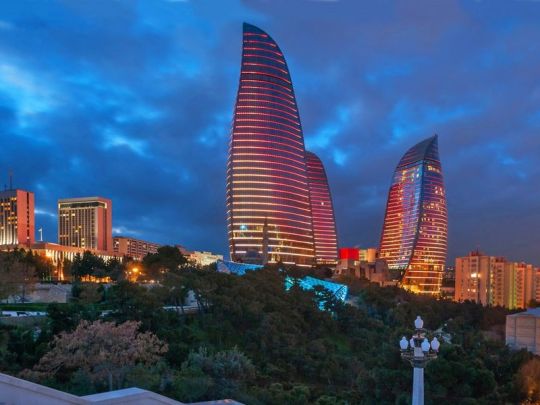
Baku, preserving traditions, confidently looks to the future and, changing its appearance with each new era, carefully preserves the heritage of past centuries. Modern architecture here is harmoniously combined with medieval fortresses and towers, ancient mosques – with cutting-edge concert halls, and oriental flavor – with the latest Western trends. Go to the capital of the Land of Lights, and we will tell you what to see in Baku for 1 day on your own, in order to fall in love with him forever and be sure to return.
How to get from the airport to the center
From G. Ailiev Airport, the center can be reached in various ways. Shuttle H1 goes directly to the center. You can buy a ticket for it at the exit from the terminal building in the machine. The ticket costs 90 cents, the journey takes approximately 40 minutes.
Another way is to use the city bus of route 116. He leaves from the airport and goes directly to the center with an interval of 30 minutes. Without traffic jams, the travel time is 1 hour. A ticket costs 20 cents, the driver sells them.
If you do not want to use public transport, you can take a taxi. Book it better in advance using any of the online taxi services. The trip will cost about $ 25 or more, depending on the class of car, and take 35 minutes.
Workshop Ali Shamsi
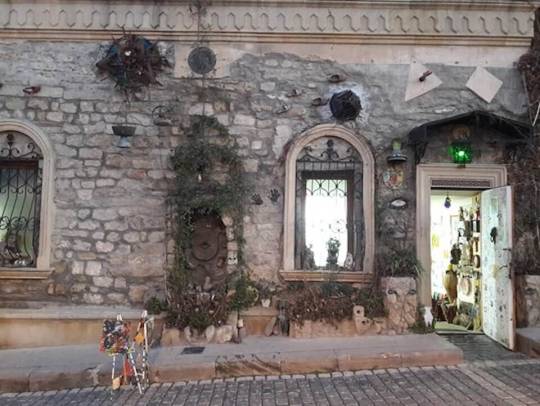
In the Old Town, on Kichik Kala Street (Malaya Krepostnaya), an unusual house will surely attract your attention. Its facade is hung with many amulets, signs and symbols, decorated with installations depicting a huge lion with unusual eyes, aliens, native oilmen. Opposite the tree grows, the trunk of which is painted with three female faces. Tourists always gather around it to take pictures. In front of the house, two artistic brushes “grow” directly from the ground.
This is the workshop of the famous Baku artist Ali Shamsi. He himself can also be found next to the house. The artist often works in the studio and invites everyone to visit his house with pleasure. Inside the house is no less interesting than outside. There are two rooms in the workshop. The first houses art objects collected by the master, brought by him from other countries or collected here in his homeland, including during excavations in the Old Town.
Subscribe to our channel in Telegram, where we daily post the most last-minute tours and flights. And in the second – the work of the artist himself. Most of them are dedicated to the nature of Azerbaijan, their hometown and, of course, women. He paints flowers, the sea, mountains, portraits of beautiful women – everything that he loves and does not get tired of admiring. His paintings, bright, joyful, very kind, will certainly find a response in your heart. The workshop is located at: Icheri Sheher, st. Kichik Kala, 84.
Museum of miniature books

On April 23, 2002, a unique museum was opened in the Old Town, not far from the Maiden’s Tower, which has no analogues anywhere in the world — it is a Museum of Miniature Books. Here are the smallest books in the world. These are rare editions of Russian classics, Azerbaijani poets and writers (including the great oriental poets – Nizami and Fizuli), books published during the Soviet years in different republics of the Soviet Union and in Europe. There is even a miniature edition of “Criminal Jokes” by Yu. Nikulin.
The exposition presents not only fiction, but also philosophical and spiritual books – for example, miniature Bible and Quran. And in contrast to them – the collected works of V. Lenin. Zarif Salakhov, the sister of the artist Tahir Salakhov, began to collect her collection many years ago, in the Soviet years. And this she began with a collection of fables by I. A. Krylov, published back in 1835.
The museum’s most valuable exhibit is one of the smallest books in the world. Its dimensions are 2 x 2 mm, but at the same time the book contains not only text, but also illustrations. True, to make out them, as well as read its contents, is possible only with the help of a magnifying glass. The museum is open every day, except Monday and Thursday from 11 to 17 hours. Free admission.
Governor’s Garden

The Governor’s Garden is the oldest in the city. It was laid back in 1830. By the decree of Roman von der Hoven, commandant of the Baku fortress, all ship owners and their captains had to bring several bags of black soil from the south so that even crops that do not like the arid climate could be grown. They planted acacia, mulberry, conifers, broke flower beds, and some exotic plants.
The result was a unique garden in which even rare, including subtropical, plants grew. It began at the walls of Icheri Sheher, and when in 1865 the outer wall of the fortress was removed, the garden expanded significantly. For a long time it was the only garden in the city. For ordinary people, entry here was allowed only once a week.
By the end of the 19th century, arbors and terraces for relaxation appeared in the park. The garden was renamed many times, it bore the names of Mikhailovsky, Revolution, im. Aliaga Wahid, but the old name – Gubernatorial – has taken root best of all. Now adjacent to the garden adjacent to the building of the Philharmonic. M. Magomayev, therefore, it is often called the garden of the Philharmonic. It stretches along the fortress wall from Azneft Avenue to the Icheri Sheher metro station.
Kichik-Gala Street, 8 – place from the movie “Diamond Hand”

In our country, the old city is familiar to everyone, even to a person who has never been to the Azerbaijani capital. Legendary Soviet films were shot here: Aibolit 66, Tehran 43, Do not be afraid, I’m with you. But, of course, the most recognizable views of Icheri Sheher are in frames from the films Amphibian Man and The Diamond Arm. Almost all overseas in the film “Diamond Arm” was shot in the Old Town. Soviet Baku at the time of filming becomes Istanbul.
Walking through the narrow streets of Icheri Sheher, you will surely find out where the sultry beauty is trying to seduce Semyon Semenych (“Tsigel, tsigel ai-lu-lu!”), You will see the walls of the Shirvanshahs Palace, against which Soviet tourists are given an excursion. And of course, no one can pass by the famous place next to the Chikanuk pharmacy, in which the main character was smuggled in plaster.
Tourists here are photographed in the same pose and with the famous phrase “Cheort beat!”. The exact address of this place is Kichik Kala, 8 (Malaya Krepostnaya, 8). Of course, now there is not a pharmacy, but an ordinary courtyard of a residential building with its measured life. To find this place, you can navigate by the nearby Thunder cafe at the intersection with Veli Mammadova Street.
Shamakhi Gate
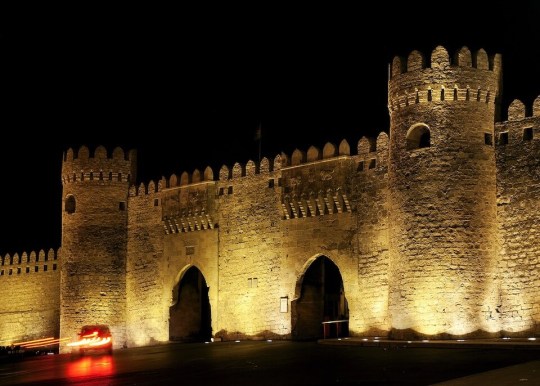
Icheri Sheher (Old Town) is not a millet a piece of the preserved ancient city. This is a unique architectural reserve, protected by UNESCO. The fortress with 25 towers and 5 gates rises above the sea and is surrounded on all sides by strong stone walls up to 8 m high, and their thickness reaches 3 m. Today you can get to the Old Town through the Shemakha Gate. For a long time they were practically the only gates of the fortress. In another way they were called the gates of Shah Abbas.
Once in the fortress there were two tiers of defensive walls. In the XIX century, when the city grew significantly and went far beyond the borders of Icheri Sheher, the governor proposed to remove the inner walls. In 1886 a decision was made, the wall was demolished, and the gates of the inner walls, called the Gate of Zulfikar (named after the shah who erected the inner walls), were moved to the Shemakhinsky.
As a result, the gates now have two arches and are often called the Twin Gates. Through the Shemakha gate you can enter the Old Town by car. But at the entrance you will need to pay 2 manat, and for each next hour to pay 1 manat.
Maiden’s Tower
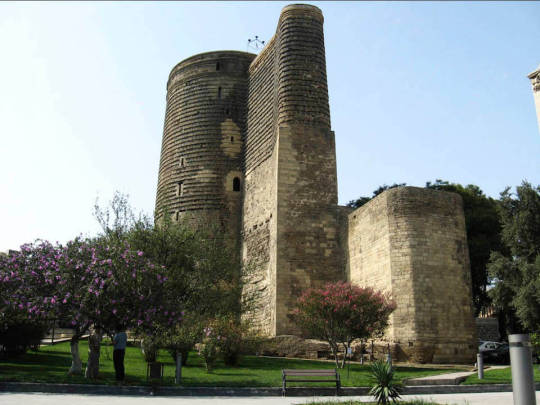
In the southeast of Icheri Sheher the famous Maiden Tower (Giz Galasy) rises, which has long become a symbol of the city. The thickness of its walls at the base is 5 m, and at the top 4 m. The height of the tower is 28 m. It is divided into 8 tiers, a spiral staircase leads to the very top. In the tower itself in the rock a well is arranged, 21 m deep. For what this tower was erected, historians still argue. According to many, it did not have a defensive function, but rather a cult function, associated with pagan times and, in particular, with worship of the Sun. The time of its construction, too, until the end is still unknown.
According to archaeologists who investigated the mortar and masonry, it could be built in the 1st century. or in the IX century. For a long time the tower served as a lighthouse. Until the 19th century, a flag fluttered at its top, which served as a guide for sailors, and from the middle of the 19th century the lighthouse began to shine. There are many legends associated with the tower. The heroine of each of them is necessarily a girl who, because of unhappy love, rushes from a tower into the sea and smashes into stones.
One of the stones in the sea at the foot of the tower is still called the stone of the virgin. This plot inspired many poets and artists to create their own works related to the legends of the Maiden Tower. Her image has become a symbol of the city. Now there is a museum in the tower, and at the very top there is an observation deck from where you can see the city. The museum is open every day, except Mondays from 10:00 to 18:00. A ticket costs 2 manat.
Shirvanshahs Palace
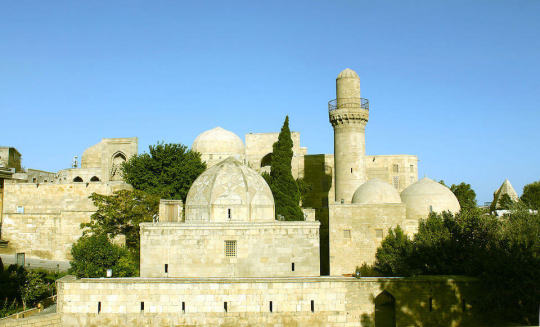
The Shirvanshahs palace ensemble is the former residence of the Shirvan shahs, a unique architectural and historical monument that was built over several centuries from the 13th to the 16th centuries. It is located on a hilltop in the center of Icheri Sheher fortress (Old Town). In addition to the rulers’ palace itself, the complex includes a tomb, a bathhouse, a mosque of the 15th century, a mausoleum of a Baku scientist Seyid Yahya Bakuvi and a courtyard Divan Khan. Despite the fact that the entire complex was not built at the same time, it is a complete, harmonious ensemble, designed in unified architectural forms and combinations of decorative elements.
Spiral staircases and the main hall are preserved in the palace, which now presents an exposition consisting of archaeological excavations – dishes, jewelry, household items, musical instruments, weapons and the famous Shemakha carpets. Household items can be considered in the remaining 52 chambers of the palace. In the courtyard – Divan Khan – there is an octagonal rotunda with columns. Her appointment is still unknown.
It is assumed that this could be the tomb or the building in which the state council was sitting. The mausoleum of Seyyid Yahya Bakuvi, the scientist who worked here under the rule of the Shirvanshah Khalil-ulla I, was connected with an arch to the old Kay-Kubad mosque, which burned down in 1918 year. In the tomb, the remains of tombstones and 14 crypts of members of the Shirvanshah Khalil-Ulla family were preserved. The complex is located in Ichera Sheher, in Palace Lane, it is open daily from 10:00 to 18:00. An adult ticket costs 2 manat, For students – 60 qepiks (kopecks), for students – 20 qepiks.
Monument to the poet Aliaga Wahid

Aliaga Vahid (Aliaga Mammadkul-oglu Iskander) – Azerbaijani poet, satirist, friend of Sergei Yesenin. Very popular among the people were not only his satirical poems, but also lyrical gazelles. A very unusual monument to the poet stands in the Azerbaijani capital in Icheri Shaher (Old Town) on Kichik Kala Street (Malaya Krepostnaya). Its authors are sculptors Rahib Hasanov and Natik Aliyev.
The monument is the poet’s huge head, which grows directly from the ground – his neck, torso and hair represent the trunk and branches of trees and at the same time the interweaving of human bodies. The monument is very interesting to consider – all the cycles of our life are presented here: birth, love, separation, wedding, funeral. According to the sculptors, all our ideas live in our heads, they decided to “pull” them out.
The monument was opened on October 27, 1990. It was built almost entirely at the expense of ordinary people, admirers of the talent of Aliaga Wahid. The idea to perpetuate the image of the poet belongs to the architect, journalist and writer Arif Mansurov. He also sponsored the installation of the monument.
Market Square
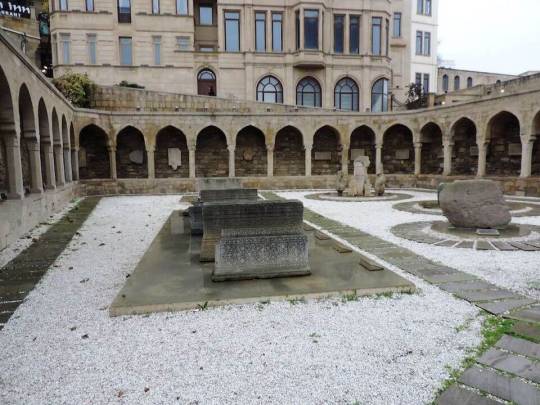
One of the oldest places in the city, Market Square, has always been indicated on ancient maps, but was discovered as a result of excavations in Ichera Sheher only in 1964. Once there was a large eastern bazaar. Gradually, the square began to carry not only trade functions, but also was the center of political and public life. Here the most important decrees of the rulers were read, court hearings were held and their decisions were announced.
However, during one of the enemy attacks, the square was destroyed. After that, it was no longer used for its intended purpose and eventually was used as a cemetery. Here archaeologists found 52 graves. On the top of the hill, under which the market square was buried, the townspeople gradually began to build houses. After archaeologists discovered and examined it, the area was cleared and landscaped. Archaeologists and restorers completely liberated it, restored the arcade, which rests on stone columns with a capital.
Mohammed Mosque
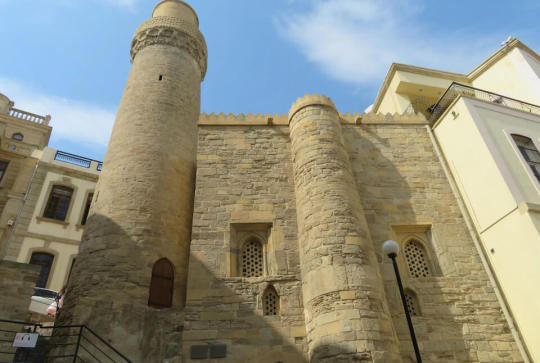
In Icheri Sheher there is also another iconic structure – the mosque of Mohammed, or the Son of Kala, which translates as a broken fortress or tower. The mosque was erected in the XI century. Here, the date of construction of the mosque was even preserved. An inscription on one of the walls says that the mosque was built by ustad-rais Muhammad, the son of Abu Bekr in 471 (approximately in 1079). It was built on the site of an even more ancient structure.
During the assault on the city by the Russian fleet in 1723, shelling of the Icheri Sheher fortress was carried out. One of the shells damaged the tower of the minaret. At that very moment a strong wind rose and carried the ships back. Defenders of the city regarded this as a sign of God. For a very long time the tower was not restored, it became a symbol of resistance and then it got its second name. The minaret is adjacent to the main building of the mosque. Its upper part was restored only in the 19th century.
Haji Gaib’s Bath
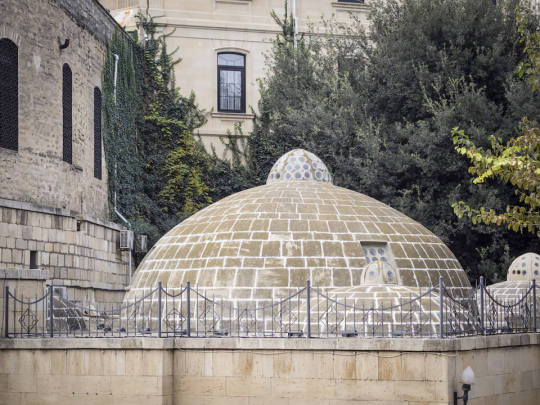
As in any eastern city, there are many baths. In the East, a hamam is not just a place intended for hygienic procedures, a visit to the bath was accompanied by a special ritual. And here they often gathered for negotiations and transactions. The bath of Haji Gaib was built in the 15th century in a very convenient location. Trade routes crossed here, and merchants from different countries gathered for ablution and business negotiations. Archaeologists discovered hammam only in the 60s of the last century.
Today, the bath of Haji Gaib, of course, is no longer used for its intended purpose. But tourists can see what a traditional hamam building was like in the Middle Ages. It consists of three rooms. The dressing room has rectangular shapes, and then follows a large central hall in the form of an octagon. It housed two pools with hot and cold water.
Under the stone tile floor, steam passed through the canals, which heated the room. Ceramic pipes also served for this. In the third room, in the locker room, they had tea after bathing, negotiations were held here, cheerful conversations and deals were made. Haji Gaib’s bathhouse is easy to find, it is located next to the Maiden’s Tower, on 5 Boyuk Kala Street.
Park “Little Venice”

Seaside Boulevard is one of the most beloved places in the city not only for tourists, but also for the Baku people themselves. Here, back in 1960, a park was built, which is a network of islands and channels connecting them. It was called Baku Venice, or Lesser Venice. In the post-Soviet years, over time, this park became desolate. Restored it and upgraded only in 2011.
Now cafes and restaurants have opened along the banks of the canals. Here appeared small green areas, flower beds, fountains and openwork bridges. On the channels of tourists carry gondolas. Special marinas were equipped for them. The length of all channels of Little Venice is 1350 m, and the depth is 1.3 m.
Azerbaijan Carpet Museum
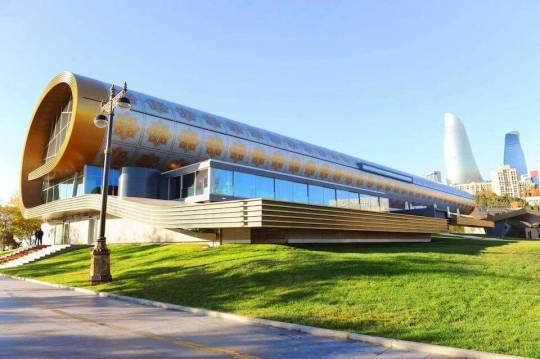
In 1967, the National Carpet Museum was opened in the building of the Juma Mosque in Icheri Sheher. In 1992, the mosque was returned to believers, and for some time the museum’s exposition moved to the Museum Center. From 2008 to 2014, the construction of a new museum building was in progress. In August 2014, its grand opening took place. The shape of the building resembles a rolled up huge rug.
The museum has a large collection of not only carpets, but also ceramics, metal products, jewelry, national clothes and embroidery. The most valuable exhibits are a fragment of the Tabriz carpet and the 18th-century carpet “Hila Afshan”. The museum presents carpets from all regions of the country, you can see the most diverse embodiment of traditional national ornaments.
The museum has its own training center where you can learn about the main schools of carpet weaving, their features, the history of the emergence and development of this type of decorative art in Azerbaijan. The museum is located on 28 M. Useynova Avenue. It is open every day except Monday from 9 a.m. to 9 p.m., but the entrance for visitors starts and ends one hour earlier. Adult ticket costs 7 manats, for pupils and students – 3 manats
Funicular
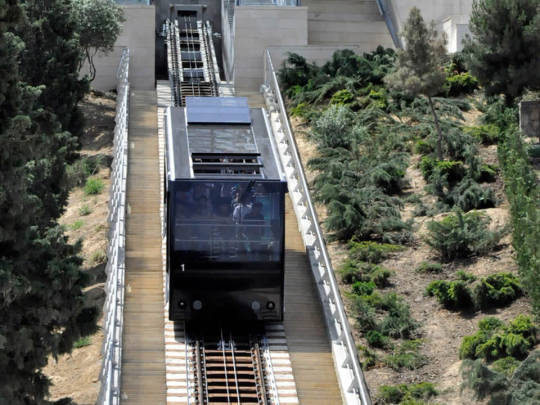
In any city built on the hills, a funicular is a must. In Baku, the first lift appeared in 1960. By the Eurovision in 2012, it was not just repaired, but completely modernized: the old cabs were replaced with new, modern ones, which operate completely silently. Now from the Bahram Gur station to the Flaming Towers can be reached in just 4 minutes. And this way only 1 minute passes through the tunnel, and the rest of the time – along the hills of the Green Theater, covered with coniferous trees.
The trailer overlooks the Caspian Sea, towers and green slopes. In the evenings you can see fantastic panoramas of the city flooded with lights, glowing oil derricks and lights in the sea. A staircase also runs along the paths – in order to return to the embankment it is not necessary to use the funicular again, you can go down on foot.
The funicular is located near the Icheri Sheher metro station. It works every day except Monday from 10 a.m. to 10 p.m. The fare is 1 manat one way. Payment is only for cash. The cars depart every 10 minutes.
Flaming towers
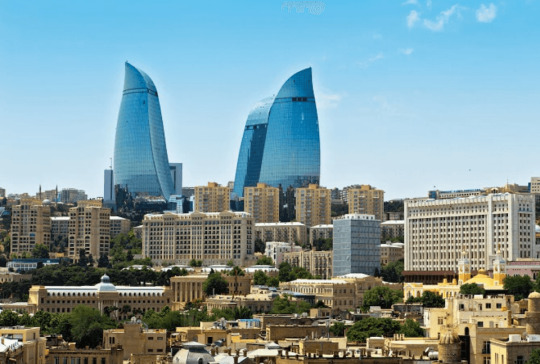
Since Zoroastrian times, Azerbaijan has been called the Land of Fires and the place of storage of the sacred fire. And the matter is not only in the oil and gas rich bowels of this land. This fire burns in the heart of every resident of this hospitable country. This is exactly what the creators of the modern architectural ensemble Flame Towers – Flaming (Burning) Towers – tried to embody in their work.
These are three tall buildings shaped like flames. The towers are considered the tallest buildings in Azerbaijan and are visible from all over the capital. When the lights turn on in the evenings in the towers, the lights turn on, and the movement of fire is shown on the monitors, from afar it seems that a fire is really blazing in the distance. They built towers for 5 years.
All buildings have different heights. The tallest tower is 190 m, the rest are 140 and 160. The towers house offices and accommodations, as well as the Fairmont Baku at the Flame Towers Hotel. It is most convenient to get to the towers from the Icheri Sheher metro station on the city funicular. It is best to view them from the waterfront.
Ferris wheel
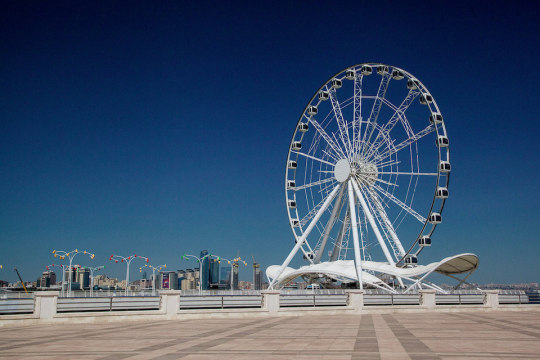
The wheel makes a full revolution at different times – from 10 to 30 minutes, because the landing takes place in 5 booths at a time. Therefore, sometimes the wheel freezes and freezes while moving – do not be afraid, after a while it will continue to move. The cabins are completely closed, air conditioners work in them, a video showing the construction of the wheel is shown on the monitor, information about the height at which it is located and the temperature “overboard” appears.
The wheel is located at the end of Primorsky Boulevard, on Neftyanikov Avenue, next to the National Flag Square. It works every day from 10:00 to 23:00. A ticket costs 5 manat, for children under 6 years old – free of charge, from 6 to 12 years old – 3 manat.
Baku “Crystal Hall”
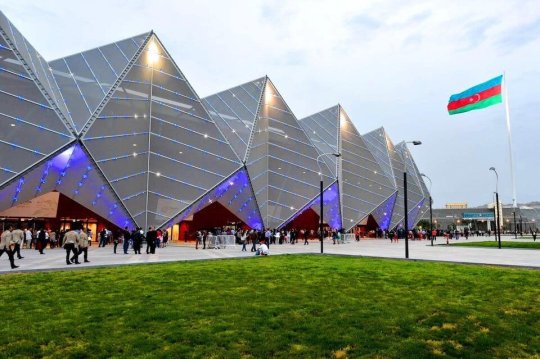
When the duet Ell & Nikki from Azerbaijan won the Eurovision Song Contest in 2011, the country began to prepare to host the festival. For this, in less than a year, a new concert hall was built. For its unique form, this concert venue was called the Crystal Hall, or Crystal Hall. The external building of the hall consists of light metal structures.
They have built a huge number of LED bulbs. With the onset of dusk, the hall begins to glow with multi-colored lights. Thanks to special spotlights, thin strings-rays stretch out from the roof of the arena, which are clearly visible from all over the city. The hall seats up to 27 thousand spectators. Its equipment allows you to realize any visual intentions.
After Eurovision, the hall remained operational. World stars (Rihanna, Shakira, D. Lopez, etc.) often perform here, events are held as part of major sports competitions, for example, the 1st European Games, the Chess Olympiad. The hall is located on National Flag Square, next to the Icheri Sheher metro station.
#Crystal Hall#Little Venice#8 - place from the movie “Diamond Hand”#Azerbaijan Carpet Museum#Baku#Baku Market Square#Flaming towers#Governor's Garden#Haji Gaib's Bath#Kichik-Gala Street#Maiden's Tower#Mohammed Mosque#Monument to the poet Aliaga Wahid#Museum of miniature books#Park#Shamakhi Gate#Shirvanshahs Palace#Workshop Ali Shamsi
1 note
·
View note
Text
Top Lamu Accommodations
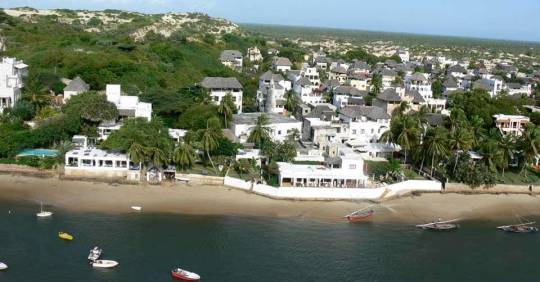
Lamu archipelago, consisting of an island, Lamu town and villages, lies along the Kenya coast north of Mombasa, and is Kenya's oldest town still in existence. Lamu began life centuries ago as a swahili settlement and today still retains the charm and mystique of an ancient town, where vehicles are not allowed, transport is by donkeys and boats and the pace of life is so relaxed one would feel far removed from the modern world as we know it. Lamu is therefore a must see location for those who aspire to get away from it all, and Lamu also has several superb hotels and guesthouses, small and boutique-like , full of character. Lamu has many attractions to explore with its fascinating past, intriguing present and exciting future. Here is a list of Lamu Hotels of this famous Swahili town as you explore the many things that it has to offer. Diamond Beach Village The Village is situated on the island of Manda, which is the sister island to Lamu. The lodge is located on the beach front with amazing views of the open ocean, Lamu island, Shela village and dhows sailing past. It is the perfect place to come and relax for days or weeks, away from the stresses and strains of everyday life. There are no cars on Lamu or Manda, the only form of transport is donkey or boat, both of which are an experience in themselves. The pace of life is inevitably slow and relaxed. The island is located roughly three degrees south of the equator therefore you can guarantee that perfect island getaway, whether it is lazing in your airy banda, on the beach or exploring the surroundings. Peponi Hotel Peponi is situated at one end of the spectacular twelve kilometre Shela Beach on the Indian Ocean. Flanked by ancient sand dunes, the beach is one of the few remaining untouched, empty stretches of coastline in Kenya. White sands, excellent swimming and an idyllic setting for a walk at dawn or sunset. Small and personal, it is the perfect rest after a safari or a hide away holiday from modern life. All rooms at Peponi have ocean views. Suites and Superior rooms are differentiated by their location, size and private outside area with swing bed. It boasts of one of the largest and most varied collections of tropical palms and exotic plants on the Kenyan coast. Swing hammocks under the shade of coconut trees and a fresh water free form swimming pool under two giant Baobab trees offer the perfect places to relax. The Majlis The Majlis hotel is a privately owned luxury beach hotel on Manda Island in the Lamu archipelago, off Kenya’s Northern Coast. With a superb beachfront location and breathtaking views over the bay and Lamu Island, it offers the perfect setting and the ideal accommodation for barefoot luxury and informal pampering. It is a perfect blend of local tradition, Swahili culture, Western comforts, and luxury. The boutique hotel combines superbly appointed luxury suites with verandas that open out to sun-drenched beaches and mesmerizing seashores. The Fort of Shela Nestled along the sand dunes of Shela Beach, The Fort has been hailed as a monument to Omani architectural ingenuity; it is the epitome of privacy and seclusion. Its architecture is truly unique and occupies an unrivaled position overlooking the Indian Ocean on the deserted 14 kilometer Shela beach. Peaceful and tranquil in its setting, surrounded by natural dunes and breezy casuarina’s. Extremely private and secure, this oasis is just a ten minute walk along the beach to Shela Village. The Fort is constructed of local coral stone and is enclosed by an imposing 50-foot high sandstone wall. The Omani-style heavy wooden entrance, decorated with iron studs, opens onto the main floor of the property, where large arches surround the central courtyard. The living area, dining area and lounge look onto the picturesque pool and garden. From the upstairs formal dining area, guests can enjoy spectacular views of the Indian Ocean as traditional dhows sail-by and donkeys and camels cruise the beach. Kijani Hotel Lamu In the village of Shela, on the island of Lamu – just off the Kenya Coast – Kijani Hotel offers a unique accommodation with its 3,000 sq. metres of tropical garden. Located at the sea front with two fresh water swimming pools, Kijani Hotel Lamu has 10 rooms spread throughout the garden into three small separate traditional Swahili buildings which formerly were private homes. True to the atmosphere of a Swahili house, Kijani’s rooms and central areas emphasize the aesthetics of privacy and space. Each room has a private veranda shaded from sight by arabesque archways and trees Lamu Palace Hotel Lamu Palace Hotel resembles a royal palace with its large open spaces and tall handsome pillars. Located on the seafront, there is always a cool sea breeze that our guests will enjoy, complemented by city and sea views, accommodation offers fine coastal living. The house has a total of 22 rooms and suites, all with en-suite bathrooms and a variety of modern amenities. Each room is furnished and decorated in a traditional Lamu style. Its grand terrace overlooks the Indian Ocean, and it’s lounge bar offers a relaxing ambiance; ideal for after dinner drinks, watching news or football. Enjoy massage parlor, boat hire, for sports and leisure beach walks, a town tour, fishing, sailing, sundowner dhow trips and donkey rides can be organised. Mikes Camp, Kiwayu Mike’s Camp is located on Kiwayu Island, one of the many unspoilt, idyllic islands of the Lamu Archipelago, on the Kenya Coast. You are offered your own private island where you are safe and undisturbed. Surrounded by miles of soft white sand, turquoise waters and gorgeous coral gardens, it offers one of the only beaches in Kenya on which you can walk for miles without seeing a single soul. The seven private and spacious bandas are set amongst the sand dunes, with panoramic views. Mike’s Camp offers tranquillity, water sports, safaris and fishing in a uniquely homely environment. The Red Pepper House Initially built as a family home, this five-room hotel north of Lamu Town is set among neem and acacia trees. It is truly beautiful, with crystal chandeliers hung from an undulating makuti and tribal masks and colonial antiques dotted among traditional Swahili furniture, including pili pili beds decorated with peacocks (a symbol of passion). Island Hotel Lamu Island Hotel Lamu is a big coral house placed in the heart of Shella village. It is built and decorated in traditional swahili style – simple and beautiful. We have seven rooms suitable for friends, couples, families, big groups – or only you if you travel alone. There are three smaller rooms on the 1st floor, two big rooms on the 2nd and 3rd floor, and two tower penthouses – each with their own rooftop. Banana House & wellness centre Banana House is a boutique hotel in Shela, Lamu Island. It has all the charms of a quietly elegant private home with 16 rooms spread over three houses situated in a magnificent tropical garden just a few minutes’ stroll to the pure white sands of Shela Beach. With its remarkable views of the sea and our beautifully gardens, Banana House is simply and tastefully furnished in traditional Swahili style. Sitting areas, day beds and hammocks are located throughout. A swimming pool is situated in an area of the garden abundant with exotic bird life. For more info and inquiries kindly contact us FACEBOOK TWITTER YOU TUBE Email: [email protected] Call us on +254 720 824 502 / +254 720 823 229 Holiday Packages Visit our WEBSITE for more offers Top Weekend Getaway Deals in Kenya If you think you have to travel far to enjoy a nice weekend, you may never get away. Besides, you can enjoy a beautiful weekend right here in Kenya. There are countless wallet-friendly Kenyan weekend getaways that won’t even break your budget. Don’t spend your weekend, doing absolutely nothing at home. Whether you are looking for romantic destinations, pristine beaches, and adventurous outdoor activities, there are plenty wallet-friendly getaways that will satisfy your weekend desires. Mombasa South Coast Self Drive Deals Lake Nakuru & Elementaita Self Drive Deals Lukenya & Machakos Self Drive Amboseli and Tsavo Holiday Self Drive Deals Mt. Kenya & Aberdare Self Drive Holiday Deals Mombasa North Coast Self Drive Deals Samburu Holiday Self Drive Deals Masai Mara Self Drive Holiday Packages Malindi & Watamu Self Drive Deals Nyahururu & Laikipia Holiday Self Drive Deals Top Madaraka Express SGR Holiday Deals 2 Nights Malindi & Watamu holiday with SGR 2 Nights Amboseli Holiday With SGR 2 Nights Tsavo Holiday With SGR Sa 2 Nights Voi Holiday With SGR 2 Nights Mombasa North Coast With SGR 2 Nights Mombasa South Coast With SGR Read the full article
#magicalKenya#makeitkenya#tembeakenya#whyIloveKenya#adventuretravel#africansafaris#besttravelagent#Kenyaholidays#Kenyasafari#Kenyavacation#Mombasabeachpackages#MombasaHoliday#Mombasahotels#Mombasapackages#toptraveldestinations#travel
0 notes
Text
in this post shared Today by John Parsons
he illuminates Hebraic History in the giving of the Ten Commandments and instructions in building the Tabernacle (and later the Temple in Jerusalem) that also reflects upon the sacred space of the heart that we open up to welcome the Spirit of God along with the sacred truth of the Word of God, of which the Ark of the Covenant represents (the True illumination of the Son who is a mirroring of the Father, as Creator and Author of the heavens and garden earth)
A beautiful reflection upon spiritual and eternal truth that we as children of Light hold dear.
do you “believe...”? as a child, love? as a daughter who has found her True identity in Love.
John’s post:
Shalom friends. Last week’s Torah reading (i.e., Mishpatim) explained how the Israelites entered into covenant with the LORD at Mount Sinai. The terms of the covenant were written down in Sefer HaBrit (“the Book of the Covenant”), which contained a variety of laws to specifically govern the Jewish people in the Promised Land. When the people agreed to obey the terms of the covenant, Moses took sacrificial blood and sprinkled it on them saying, “Behold the blood of the covenant that the LORD has made with you in accordance with all these words” (Heb. 9:18). Moses then re-ascended the mount to receive the tablets of stone inscribed with the Ten Commandments and to learn additional Torah from the LORD.
Now the goal of the Sinai revelation was not only the giving of the Ten Commandments to the Israelites but more importantly enshrining the Divine Presence within their hearts... Therefore in our Torah portion for this week (i.e., Parashat Terumah), we read how God asked the people to offer “gifts from the heart” to create a “place” for Him: “Let them make for me a holy place that I may dwell in their midst” (Exod. 25:8). The Hebrew word for “holy place” or “sanctuary is mikdash (מִקְדָּשׁ), which comes from the root word kadash (קָדַשׁ), “to be set apart as sacred.” A mikdash is therefore a “set apart space,” or a “holy place” that represents something profoundly treasured - a place of beauty and worship, a refuge, a place of rest. Other words that share this root idea include kedushah (holiness), kiddushin (betrothal), kaddish (sanctification), kiddush (marking sacred time), and so on. When God said, “Let them make for me a mikdash,” then, he was inviting the people to make a sacred place within their hearts for His Presence to be manifest.... The “materials” required to make this place - gold, silver, brass, red and purple yarns, fine linens, oils, spices, precious stones, etc. - were ultimately from the heart, expressed in free-will offerings given to God.
The LORD then showed Moses the pattern (i.e., tavnit: תַּבְנִית) according to which the Mishkan (tabernacle) and its contents were to be constructed. First an ark of acacia wood was to be overlaid with pure gold inside and out. The ark was to be fitted with gold rings and gold covered poles to make it portable. The two tablets of the law were to be stored inside the ark. Two cherubim (angel-like figures) were to placed facing each other over a cover of the ark called the kapporet (i.e., “Mercy Seat”). The ark was to be housed within an inner chamber of the tent called the Holy of Holies. Adjacent to the Holy of Holies was a second chamber called the Holy Place. This chamber would contain a table overlaid with pure gold that held twelve loaves of bread along with a golden, seven-branched menorah. The Holy of Holies was separated from the Holy Place by an ornamental veil called the parochet.
The design (or pattern) of the tent along with its exact dimensions was then given. The tent was intended to be portable, with a wooden frame covered by richly colored fabric and the hide of rams and goats. The outer courtyard was to include a sacrificial altar with horns of copper set at each corner. The portion ends with a description of the outer court, which was to be entirely enclosed by an ornamental fence made with fine linen on silver poles with hooks of silver and sockets of brass. [Hebrew for Christians]
2.24.20 • Facebook
1 note
·
View note
Text
7 simple ways to create a Scandi-style retreat in your outdoor space
Whether it’s secrets to living a happier life or how to create a cosy, minimalist aesthetic in our homes, our love affair with all things Scandinavian has certainly picked up momentum in recent years.
Looking to refresh your garden or balcony? Why not consider tapping into a pared-back Scandinavian style. Our outdoor spaces have become much-needed places of refuge as of late, so now is the perfect time to transform yours.
You're reading: 7 simple ways to create a Scandi-style retreat in your outdoor space
‘In Sweden, we spend a lot of time outdoors. Especially in summer, when daylight hours are longer, and evenings are warmer,’ says Catharina Björkman, lifestyle expert at Contura. ‘There are numerous benefits to being out in the fresh air, and by creating a secluded outside retreat you can immerse yourself in nature whilst still enjoying the comfort of your own private space.’
But there are some key considerations to make. ‘Treat your secluded spot as a digital-free zone and as somewhere to relax and de-stress away from gadgets and screens; this is crucial to boost happiness and wellbeing,’ Catharina explains. ‘For the design, look to Scandi interior inspiration and embrace the principles of lagom for a sense of balance. Think minimalist furniture, plants, faux-fur throws, bunting and soft lighting.’
Get some inspiration below…
1. Choose your spot outside
Scandinavian design is one that’s celebrated by many, thanks to its inviting, calm and simplistic feel. To get started on transforming your space, choose which area outside you want to work on (if you can, opt for a spot that catches the sun). Next, define the space using seating, flooring, cushions and large outdoor plant pots.

Catharina adds: ‘If you are using a wall or garden fence, you could add artwork (metal or stone is best to withstand the elements) to further enhance the feeling of an extra room. Don’t forget to add some form of shade for hot days; a canvas awning or sail shade are inexpensive, yet stylish options.’
2. Patio or paved areas
If you are lucky enough to have a patio or raised decking area, make the most of it. Choose a corner to place cosy cushions, warm throws, fairy lights, garden hammocks or lanterns to easily transform it into a charming seating area.
Remember, with Scandinavian design, minimalism is key; don’t go overboard with accessories but also don’t be afraid to experiment with textures and neutral colours.
Alternatively, if you have a smaller garden without a patio, you can create your own seating area using cost-effective pallets or wooden crates. These can be purchased from hardware stores and some online garden retailers.

KatarzynaBialasiewiczGetty Images
3. Transform your shed
Got a shed in need of some TLC? ‘The humble garden shed can be easily updated to create a Scandi retreat, but this does mean you can’t use the shed for storage,’ says Catharina.
If you want to transform yours, first give it a good deep clean to get rid of dirt, dust and cobwebs. Next, paint the walls in a light natural colour, then hang bunting (this can be purchased online or easily made yourself using excess fabric). Fairy lights, cushions, blankets and throws will create a cosy atmosphere, too. The only problem would be having to come back inside at the end of the day…
4. Upcycle old furniture
If you’re on the hunt for a creative project then why not upcycle second-hand or tired-looking furniture? You don’t have to spend money on new items to achieve the shabby-chic Scandi look in your garden.
‘Wooden crates make excellent coffee tables, sand down and repaint any old garden furniture, and look for second-hand decorative items such as lanterns or rugs,’ suggests Catharina. ‘You could make your own bunting and soft furnishings (such as cushions and throws) and design your own artwork if you’re a keen crafter.’
This content is imported from Instagram. You may be able to find the same content in another format, or you may be able to find more information, at their web site.
5. Lighting
Hang fairy lights or festoon lighting around your seating area to create a welcoming atmosphere. Instead of harsh bright lights, opt for a softer, warmer hue (such as yellow lighting).
Catharina adds: ‘Add candles to the table and choose an array of candle sizes and styles, avoiding anything too matchy-matchy. You can also get outdoor solar-powered fairy lights, which come on automatically when it gets dark and will glow for several hours.’

Shop decorative outdoor lights at Lights4Fun
Lights4Fun.co.uk
6. Incorporating natural textures
Much of Scandinavian design is inspired by nature, Nordic forests and the sprawling green spaces they have around them. When creating your own Scandi retreat, incorporate natural textures such as rattan, wicker furniture, cotton, stone, leather, linen and faux-fur throws. Keep the colour palette cool and calm: white, greys and soft hues of beige will tick all the right Scandi boxes.

7. Update your balcony
If you’re a city-dweller with a balcony then why not transform your space with fairy lights, a small bistro table, plants and delightfully soft cushions.
Catharina suggests: ‘Get creative with how you style your plants; an old step ladder can provide great shelving to display plants in a stylish way, for example. You can also grow culinary herbs (rosemary, mint and sage) on a sunny balcony in zinc pots, which look decorative and are useful for cooking.’
Grab a book and while away a lazy Sunday afternoon…
Read more: How to Build a Raised Garden Bed
Like this article? Sign up to our newsletter to get more articles like this delivered straight to your inbox.
SIGN UP
20 garden bistro sets perfect for alfresco dining (and a spot of relaxing)
Best wooden bistro set
Roma bistro set
Best compact outdoor bistro set
Tice Garden Compact Bistro Set, Green
Perfect for urban spaces, we love the soft, rounded design of this garden bistro set, and the chairs tuck perfectly underneath the table when it’s not in use. It’s perfect for compact spaces, especially a balcony or small patio, and is available in several colours including green, chartreuse, grey and teal.
Best contemporary bistro set
Outdoor Bistro Set – White
Crafted from FSC certified teak, the chairs are topped with a plastic seat and back rest, while the table boasts a timeless slatted design. The white colourway makes it ideal for a contemporary garden.
Best sustainable bistro set
Duraocean Bistro Set
This hard-wearing, fully recyclable and stylish garden bistro set is perfect for the eco-conscious shopper, and it’s a great sustainable buy. The chairs are made with 100% recycled plastics from marine debris, and the table is made from FSC approved Eucalyptus.
Most relaxing garden bistro set
Aruba 3 Piece Bistro Rocker Set
This is a bistro set with a difference! These rocking chairs are made for relaxing, and sipping on a drink or two. The set includes two rockers and a matching table, with tempered glass top.
Best mosaic bistro set
Morocco Garden Bistro Table & Chairs Set
Enjoy alfresco dining with this Moroccan-inspired bistro set. With an intricate tile detailing, soft padded cushions and powder-coated steel frames, this weather-resistant style is great for adding some character to your garden.
Best holiday-inspired bistro set
Garden Gear Leon String Bistro Set
thompson & morgan
£169.99
Relax in style with Thompson and Morgan’s modern bistro set. The chairs have been inspired by 1950s Mexican furniture and aims to be as comfortable as possible.
Best bar bistro set
vidaXL 3 Piece Bistro Set Solid Acacia Wood
This outdoor bar bistro set is perfect for enjoying drinks and a quick bite to eat. With a high-quality acacia wood construction and a natural oil finish, this durable bar set is weatherproof and easy to clean. The tabletop even has a parasol hole if you want some shade when the sun’s out.
Best bistro set for a balcony
2 Seater Balcony Bistro Set
We love this space-saving bistro set for a balconies, which is perfect for those of us who live in the city. Both the table and the chairs fold away easily, so you won’t have to worry about it taking up too much space.
Rustic garden bistro set
Cabo bistro set
Gardens are a place of refuge, so it’s important we make them as inviting as we can. We love this rustic-style bistro set from Cox & Cox which has been hand-woven with a unique synthetic roped weave. It has also been made from rust and weather-resistant materials, so it’s suitable for the outdoors all year around.
Best bistro set for the family
4-Seater Bistro Set
Easy to clean bistro set
Read more: History of Gnomes | LoveToKnow
vidaXL 3 Piece Folding Bistro Set Plastic Green
Made of durable plastic, this bistro set is weather resistant and easy to clean too. The table and the chairs can be folded and stored when not in use.
Best budget bistro set
Helsinki Bronze Bistro Set
Keep it simple with this stylish bronze bistro set, perfect for any size garden. The chairs are foldable too.
Best foldable bistro set
Eve 2 Seater Bar Bistro Set – Sage
Looking for a bar style bistro set? This 2-seater from Argos is a great budget buy. Slimline and made from durable metal, the high table and chairs fold down easily and simply for storage.
Most stylish garden bistro set
Faro Bistro Set in Grey
On the hunt for a more modern style? This smart grey set from Cox & Cox features two comfortable chairs and a small round table for for drinks. It’s also available in blue, too.
Indoor/outdoor bistro set
Pack of New Acapulco Chairs (x2) & Table (x1)
Available in a range of bright colours and with a metallic iron structure, this bistro set combines design and comfort and can be used outdoors. Store away safely during winter.
Best rattan bistro set
Tara Natural rattan side table and two chairs set
If you’re looking for a modern rattan style, then this bistro set is worth the investment. Both the table and chairs are made from synthetic rattan, which means they can be left outside all year round. We love the unique Insta-worthy round table, too.
Slimline outdoor bistro set
Georgia FSC Eucalyptus Wooden Bistro Set
Slender bistro set
Cote Bistro Set
With slender, hand painted grey frames and a decorative curled finish at each arm, this garden bistro set is rather charming. The granite topped table adds an elegant touch, while the chairs are topped with grey water repellent cushions.
Best metal bistro set
Folding Metal Bistro Set Orange
This foldaway bistro set in vibrant orange is brilliant if you want to add a pop of colour to your garden. Best of all, it’s lightweight and is easy to store away when not in use.
Like this article? Sign up to our newsletter to get more articles like this delivered straight to your inbox.
SIGN UP
This content is created and maintained by a third party, and imported onto this page to help users provide their email addresses. You may be able to find more information about this and similar content at piano.io
Source: https://livingcorner.com.au Category: Garden
source https://livingcorner.com.au/7-simple-ways-to-create-a-scandi-style-retreat-in-your-outdoor-space/
0 notes